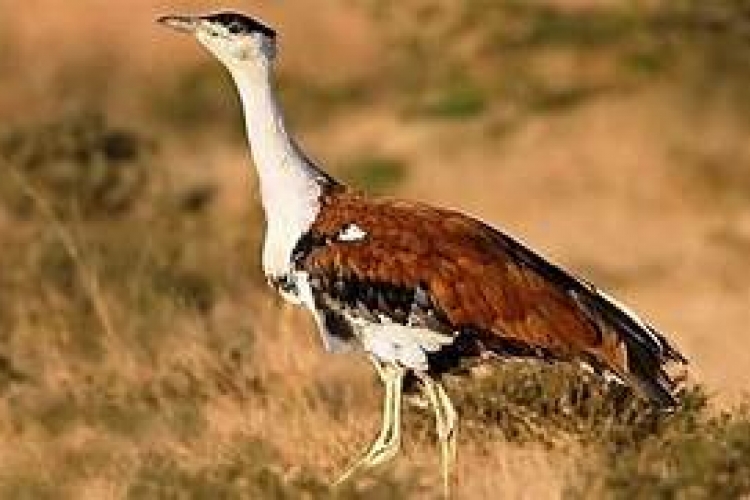THE GREAT INDIAN BUSTARD
IN NEWS
The great Indian bustard, that narrowly missed being christened India’s national bird, is now teetering on its last legs. Several threats — including power lines — are decimating bustard populations. India, effectively the only home of the bustards, now harbours less than 150 individuals in five States.
GREAT INDIAN BUSTRAD
The great Indian bustard is a large ground bird with a height of about one meter, with a horizontal body and long bare legs, giving it an ostrich like appearance, this bird is among the heaviest of the flying birds. It is Listed in Schedule I of the Indian Wildlife (Protection)Act, 1972, in the CMS Convention and in Appendix I of CITES, as Critically Endangered on the IUCN Red List and the National Wildlife Action Plan
FACTORS FOR DECLINE
- While hunting was probably one of the first factors despite being listed in Schedule I of India’s Wildlife Protection Act, bustard habitats have undergone tremendous change over the last decades.The bird’s natural habitat is grasslandsand the overemphasis on forests as the habitat for all animals and birds has led to the neglect of such a precious ecosystem.
- The biggest threat to their shrinking habitat has been industrialisation, mining, and intensive agricultural practices.
- Consequently, these lands are very easily acquired for development activites, all of which fragment the habitat and degrade that ecosystem.
- The untamed, arid grasslands that bustards thrive in are categorised as ‘wastelands’, like most grassland habitats in India. The push to make these areas more ‘productive’ has seen an increase in water availability in these parts, resulting in the spillover of agricultural land into bustard habitats.
- Data suggests that the wide-ranging birds disperse to agricultural landscapes near Gujarat’s Kachchh during the non-breeding season. Yet, intensification of agriculture — including more pesticides, barbed-wire fences and new crops endangered the birds’ survival in this landscape.
- More recently, what remains of their grassland homes are now sites for renewable power projects. With new wind turbines, come more power lines to take the ‘green’ energy to grids and homes.
- Bustards, with their poor frontal vision and heavy bodies, cannot manoeuvre away from cables in time. On a survey over the last year, the Wildlife Institute of India (WII) found four bustards charred to death due to collisions with power lines in the Thar landscape alone.
- Their survival is also threatened by stray dogs which are known to attack the bustard’s eggs and young ones.
- The GIB is a particularly non-intrusive and simple bird species that has shy habits. Therefore, it has very little defense against the march of human development.
- Conservation efforts for this bird have proven difficult because it is not exactly a bird people would call charismatic. So, funds and attention is hard to find.
CONSERVATION EFFORTS
Efforts are being doubled to ensure that the remaining population of this bird does not die out.
- The bird festivals is being organized largely to draw attention to rare and beautiful species of birds, while simultaneously decreasing tourist pressure on wildlife sanctuaries and national parks .
- WWF-India has provided inputs in developing the ‘Guidelines for the State Action Plan for Resident Bustard Recovery Programme’.WWF-India, is undertaking initiatives towards conservation of GIB in and around Desert National Park.
- Great Indian Bustard has been identified as one of the species under component- “Recovery programme for saving critically endangered species and habitats” of the Centrally Sponsored Scheme ‘Integrated Development of Wildlife Habitats’, wherein financial assistance is given for recovery programme of the species.
- Further, the Central Government has constituted a Task Force to formulate an action plan for the conservation of Great Indian Bustard in India.
- Rajasthan forest department, finally announced its own Project Great Indian Bustard constituting enclosures and securing inviolate areas to ensure successful breeding of birds in the Desert National Park.
WAY FORWARD
The local population of the great bustard in Spain recovered after the threat from power lines were neutralized .Similar efforts need to be made in India with active involvement of the central government. Power lines in grasslands, if placed underground, would go a long way in protecting these birds.
More importantly, the habitats of the GIB need to come under the “protected” category. These protected landscapes need to be extremely protected especially during the breeding season and for a few months after it.
Ex-situ conservation is being heavily relied on today, to ensure the birds are bred and grown in captivity to ensure their survival. However, due to the life-cycle of this bird, the results do not seem to be as effective as it has been for other species . The removal of eggs and birds from the wild should be done only when there is high chance of survival in captivity, which does not seem to be the case for GIB.
However the efforts to protect this species must be renewed with greater vigor. The wild population can regenerate even now if the most favorable conditions are provided for it, and the birds will live to see another decade.


 IAS -2025 Prelims Combined Mains Batch - III Starts - 14-04-2024
IAS -2025 Prelims Combined Mains Batch - III Starts - 14-04-2024